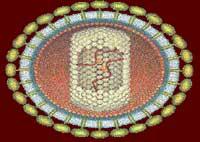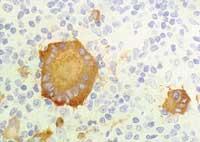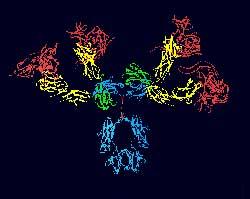AIDS research: need for the vaccine
2001/12/01 Roa Zubia, Guillermo - Elhuyar Zientzia Iturria: Elhuyar aldizkaria

AIDS research: need for the vaccine
The preparation of the HIV vaccine is very difficult for different reasons. On the one hand, the virus has great versatility, that is, it is easily mutable and resistant to a new drug. Many forms of the virus are known. In addition, no absolutely immune group is known to be able to investigate what this immunity consists of.

On the other hand, other viruses that contaminate animals, such as the one that contaminates monkeys, can be studied. Similar symptoms and pathologies. Because of these similarities, this type of research has given great benefits to understanding HIV immunopathology.
However, the most similar viruses present significant differences in the efficacy of the vaccine. For example, the monkeys virus contains a non-human Vpx protein that contains a Vpu gene that does not contain the monkeys virus. Other genes, even if they are in both, do not have the same function in both viruses. Thus, vaccines tested with animals do not guarantee the success of their use with humans.
Strategies and strategies Strategies
HIV infects some immune system cells: CD4+ lymphocytes, macrophages, and dendritic cells. Other cells do not contain CD4 protein, so the virus cannot spread them. The infection causes cell death; when the body cannot fight it, the number of cells decreases and symptoms of AIDS appear. Therefore, follow-up to the development of the disease is done by measuring the number of T cells (CD4 + T cells) containing the CD4 protein.
Against this situation, two main roads are being addressed. On the one hand, it aims to strengthen the response of the immune system and, on the other, apply any product that can interrupt the functioning of the virus. They are two lines of research, but in order to combat AIDS, a single treatment can be needed to work on both.
Looking for the vaccine
Protective cells are usually launched to fight infection of the viruses. In this sense, the goal of the vaccine is to facilitate and promote this activity, promoting the production of antibiotics. But in the case of AIDS, HIV infects some of these protective cells, specifically CD4 + T cells. The immune system is unbalanced. That is why the virus is successful and that is why it is very difficult to develop an effective vaccine. The vaccine should strengthen other cells (CD8 + T cells) that are not contaminated, but this is not an easy task. Studies show that without the help of CD4 + T cells, they cannot properly undertake their work.
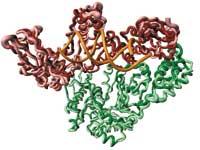
The response to CD8 + T cells at the beginning of the infection is violent. But the virus has several mechanisms to overcome the influence of these cells, among which various mutations can occur and can finally have serious consequences. To overcome the mechanism, genetic material can move, putting more obstacles to the immune system.
In addition, it can promote the synthesis of antivirus antibodies. Antibodies inactivate the viruses before they contaminate the cells and launch protective cells (neutrophils and monocytes). Therefore, although antibodies do not kill the virus, they cause the amplification of the immune response. Antibodies that know the external membrane of the virus have already been created in the laboratory, but this antibody is not very effective.
The production of antibodies is encouraged through units of viruses weakened by many diseases. This methodology is dangerous, since if the virus has not "weakened" properly it can cause infection and disease.
In the case of AIDS, research was carried out with the virus that contaminates monkeys. To weaken it, scientists removed the gene called nef and contaminated some macaques. The initial results were good, since antibodies were formed, but over time the virus moved and caused pathologies to monkeys.
Many other substances have been tested to promote the production of antibodies, such as DNA fragments and virus parts, but so far no effective treatment has been prepared. To strengthen the defense system, a vaccine should strengthen the two types of T cells, CD4+ and CD8+ T cells. However, despite the response of both, it is convenient to add other compounds that attack the mechanism of the virus.
Chemotherapy Chemotherapy Chemotherapy
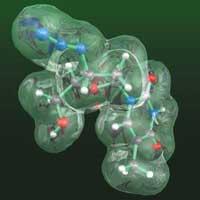
HIV has been in the body for years before developing the disease. However, many studies have shown that in this step they are constantly replicated. The virus is dispersed by the grooves of biological tissues. For this reason, chemotherapy will never completely cleanse the virus, although antiretroviral therapy can become a chronic disease.
Each inhibitor or has the ability to reduce the number of viruses in the blood. However, its use has many problems. The most serious thing from the point of view of the patient is the regularity required by the treatment. To be effective, it is necessary to take drugs with a strict frequency. In case of failure, the virus can rapidly proliferate in the blood and develop the disease without control. It does not occur in other chronic infections; it is a characteristic of AIDS.
Pharmacological problems also occur, since the body of each patient assimilates the drugs at different levels. Therefore, the same dose of the same drug can cause toxicity in some people, proper effects in others, and not effects in others.
Finally, its own toxicity is a problem. There are no drugs that to a greater or lesser extent are not toxic. In the case of AIDS, there are many side effects. Thus, the patient faces opportunistic diseases. Many times people with AIDS die from pneumonia or other diseases. In its day, this toxicity was recognized as an alternative to death.
However, when it comes to a chronic disease, this alternative is not acceptable. For this reason, one of the main current research fields is the interruptions of the programmed treatment in the field of AIDS. Experts consider that in these small interruptions the response of the immune system would be encouraged and combat toxicity.
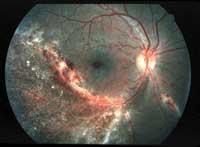
These problems cause not a single drug to be taken, but mixtures of several inhibitors. This is known as antiretroviral therapy (Highly Active Anti Virretroal Therapy, HAART). These 'cocktails' contain at least three components, an option is the introduction of two nucleosides and an anti-protease against the reverse transcriptase, but other combinations are also used. The goal of treatment is to keep the number of viruses below the detection limit. The cocktails are made with the lowest number of drugs possible, so currently, those with three components are preferred.
Other investigations
Other lines of research to treat the disease are underway, for example, with the aim of avoiding interaction between the virus and cell membranes. However, biologists also study aspects such as neurological damage and apoptosis (programmed cell suicide) in dementia of the disease in the brain. This is because HIV infection is effective and is associated with eleven biological effects, so the patient must be treated. It is not known if you will get a vaccine in the coming years, but since AIDS has become a first-world disease, many research resources are being used.
Immune system
When microbes enter the body of animals or plants, they have no facilities to survive, as they have to overcome the attack of certain cells. These protective cells are present in all fluids of the body and can quickly reach anywhere through the lymph and blood.
If the bacteria get through the skin, the response system of the protective cells is launched. Granulocytes, monocytes, and other similar cells move to the infection area. There they swallow and kill strange microbes.
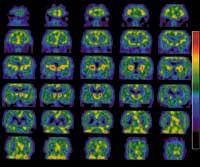
On many occasions, this simple system is not able to cope with an infection. Then, the immune system must have a more "elaborate" response. The objective is to form antibodies that allow to recognize and attack automatically in case a new infection of the same microbe occurs. This is what is known as acquired immunity, which can last on occasions, as in the case of measles, and on other occasions, only in the short term, as the flu.
White blood cells, lymphocytes, and macrophages are involved in this response. The main types of lymphocytes are B cells and T cells. B cells make antibodies and T cells and macrophages kill already contaminated cells. The entire immune response is organized by T cells.
The differentiation of cells and strangers that are wanted to protect is fundamental. For this purpose, cells use specific intermolecular knowledge. Therefore, the immune system is very complex and there are many types of interactions between cells. If errors occur, serious diseases can occur.
HIV contaminates T cells and macrophages, so it affects a secondary immune response. It produces acquired immunodeficiency syndrome, AIDS.
Retrovirus inhibitors,
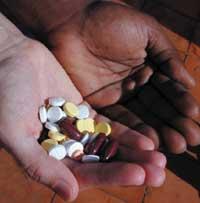
The antiretrovirals have tried from the beginning to provoke the blocking of two steps of the replication process. In the first, the reverse transcriptase protein makes the copy of the RNA of the virus in the form of DNA. In the second, it distributes through a protease the parts of proteins that the cell needs.
Because the reverse transcriptase and polymerase DNA protein have a similar role, the known inhibitors of the latter were tested with the transcriptase. The main inhibitors are special nucleosides that act as signals to stop the synthesis of DNA. The protein lengthens the DNA chain by adding normal nucleosides, but if you take one of them, finish the work without transcribing the entire RNA. To avoid this step, chemical compounds of similar effect are used.
To stop the protease, other molecules similar to the peptides that this one needs are introduced into the cells.
Conventional drugs Conventional medicines
ProteasAbacavir (ABC) inhibitors Didanosine (ddl) Lamivudine (3TC) Stavudine (d4T) Zalcitabine (ddC) Zidovudine (TR) Efavirenz Delavirdina Nevirapir AvinavirTowards low variability molecules
One of the most important goals of the international scientific community is to develop an effective vaccine against HIV, in which I think we all agree. For the moment, the effort has not given the expected results. The first attempts of attenuated viruses were very positive, but one of the greatest advantages of Human Immunodeficiency Virus is its high mutation capacity from the point of view of the virus. The accumulation of mutations in the attenuated virus used as a vaccine can cause in the medium or long term a resurrection of the virus, with unimaginable consequences. The new trials carried out in animals by different research groups have partially confirmed this last point.
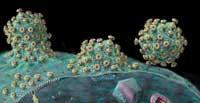
However, significant advances have been made in the field of HIV therapies. I refer to protein inhibitors and reverse transcriptase. These drugs, of common use, have managed in many cases to control the disease in the infected individuals. But, once again, the ability to mutate the virus makes strains resistant to these drugs appear. In addition, long-term problems of tolerance to these treatments are raised in the organism. These therapies aim to block the function of specific molecules that only appear after infection.
Although we are still far from knowing the right method to neutralize HIV, it is true that the current situation, even though all of the above seems a lie, is optimistic. In science, as in other areas of life, we learn as much or more invented from mistakes. The understanding of the mechanism of entry of the virus in the cells of the organism has led to the development of new vaccines and inhibitors. Molecules with high degree of conservation involved in this phase of the viral infective cycle. That is, they are so important to the virus, that in all the strains that have appeared they remain practically unchanged (they are out of the mutation capacity of the virus). If the virus cannot enter the cells, it cannot multiply, so the infection cannot advance. HIV remains less and less resources.
Asier Saez-Cyril Biochemical

Gai honi buruzko eduki gehiago
Elhuyarrek garatutako teknologia




